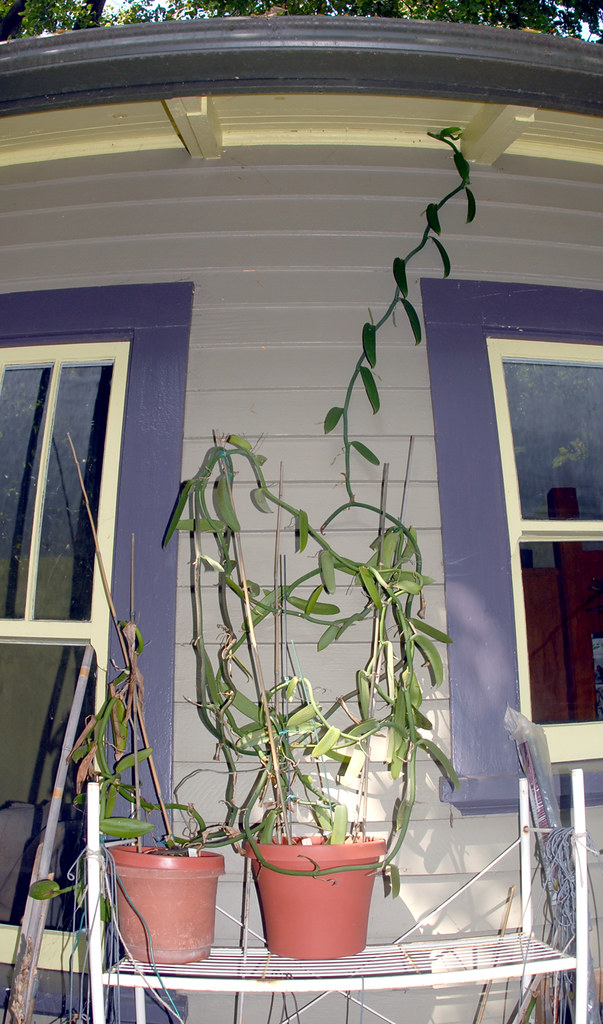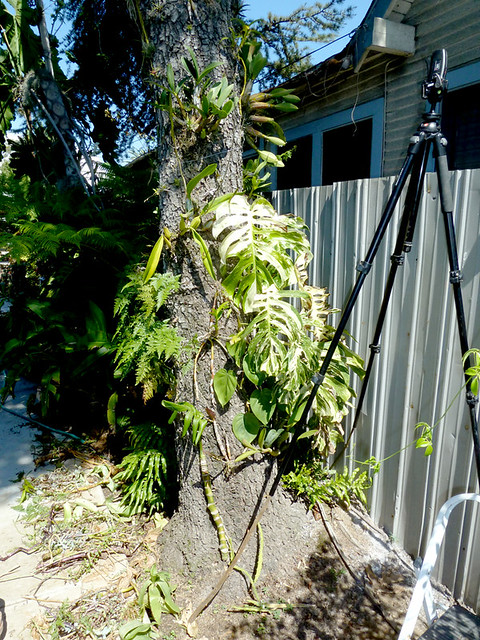Erik and I are also friends on Facebook but it's been a while since I've checked out his personal page. Recently I did so and found this pic...
Here's what he wrote...
Rainy day image. Rarely do I grow a single plant in a pot. Companion planting holds secrets. As I observe these species in habitat, it’s evident evolution is not about the individual, rather responses to relationship. Bromeliads collect water that overflows to their root base, where mosses and hepatics grow, further stimulating seed germination and eventually the influx of vascular plants.
The community of species is more resilient than the individual. - Erik Van Zuilekom
Exactly!
Thanks to this thread in the forum for Epiphytic Myrmecophytes, I learned that Stone Jaguar created a website... Exotica Esoterica, which contains many treasures such as this Bonsai Diorama. I first learned about his exquisite companion planting when he shared it in this thread of mine in the Agaveville forum.
What's the difference between grouping people and grouping plants? In both cases, some combinations are certainly better than others.
Here's a pic of my tree in 2011...
The tripod is there because I was trying to take a picture of the orchid seeds that germinated on the bark. You can see that the rabbit's foot fern (Davallia) was making its way to the sunny side of the tree. At that point I think it had already smothered, and killed, a couple of orchids so I ended up removing it completely. The variegated Monstera hadn't killed any of the other plants... yet... but it was quickly taking up more and more space that could be used by a wider variety of plants. I didn't remove it entirely but I did remove the portion of the stem that was in the ground. This slowed it down... and it survived for several years... until the drought caused me to reduce summer watering of the tree from 3x to 2x a week at night. This was the last straw for the Monstera.
In this short-time lapse video, you can see Jerry, Gene, Fernando and I removing a Monstera from the base of Jerry's big Catalpa tree. This freed up a lot of space that could be used to grow a wide variety of other plants. The same thought came to mind when this past weekend I saw Gary's Jacaranda tree covered in monstera...
It's a matter of getting the balance right.
One of the most important parts to get right for companion planting is the host. Pretty early on in my epiphyte experimentation I cut some large branches which I suspended and attached numerous orchids to. The branches lasted for several years but eventually they deteriorated and the orchids had to be removed and remounted. It's convenient to be able to use large hanging branches... so what's the solution? What about Ficus?
Here's a companion planting that I created on Aug 16 this year...
It's a largish branch from my Cedar tree that has the following plants attached to it...
Ficus thonningii
Kalanchoe uniflora
Microgramma vaccinifolia
Platycerium willinckii (from Barbara Joe)
Worsleya procera (from Dave)
The Ficus was a well-rooted cutting that had been happily growing in a pot. I removed it from the pot and washed off the dirt from its roots. Next I tightly attached it to the Cedar branch and added quite a bit of New Zealand Sphagnum moss around its roots which I covered with shade cloth. I stapled the shade cloth closed and cut a square on one side where I placed the Platycerium. Not sure if it was necessary to remove a portion of the shade cloth... I'm guessing that the Platycerium would have rooted through it. Before using fishing line to attach the Platycerium, I placed the Kalanchoe, Microgramma and Worsleya partially behind it.
I suspended the branch in the small area that I water most frequently and the Ficus pretty quickly started growing new roots. Here, if you look closely, you can see one just starting to poke through the shade cloth...
The Kalanchoe roots, on the other hand, are going in the opposite direction.
So far the exposed Ficus roots have been "air-pruned"... but more and more of them keep poking through the shade cloth. How much progress will they make over time? Will they be the root equivalent of stalactites? For those of you who still haven't seen it, the Ficus thonningii at the LA Arboretum has by far the best aerial roots of any tree in California.
What will happen to the Worsleya procera? It's a super nice, and quite expensive, bulb. Dave was really generous to give me two seedlings that he grew from seed. I put each one in pretty much pure pumice. So far they've both been very slow... but one is faster than the other. Somehow, even though it was on a second shelf, some cats managed to knock over the slower one. I decided to give it more peat... and it seemed to respond to the additional moisture... but then I started getting nervous about it not having enough drainage during the winter. When I unpotted it for inclusion in the companion planting, I noticed that the roots didn't look so great. Now it gets frequent water but the drainage is excellent. Not too long ago a new leaf started to emerge. It might be because of the moist moss... or maybe it's because it now gets a lot more sun... as you can tell from the photo.
One potential problem is that the Ficus roots will quickly "use up" all the moss and not leave any for the Worsleya. The two ferns will slowly make new medium but I think the Ficus will probably compete it away from the bulb. The bulb would have faced even more competition for limited medium if I had included an orchid. But there are some orchids that aren't very vigorous rooters so I might add one or two of those.
The Kalanchoe can get by without much medium. Check out Erik's Kalanchoe uniflora. Wow! I wonder how much medium it has.
By the time the Cedar branch starts to fall apart... will the Ficus branch be developed enough to carry the community?
The next month, on 20 Sept, I created another Ficus-based mount for the piece of Vanilla that Julia shared with me. I met her through the LA/OC trading group on Facebook. She easily has the biggest house-grown Vanilla that I've ever seen. Here it is outside...
Here's the piece that she shared with me...
Here's a context photo...
The branch was freshly cut from my Ficus lutea tree. To get the moss to stay on the branch I covered it with shade cloth which I stapled to the branch. Here's what I included in this planting...
Aloe bellatula hybrid? seeds (from Julia)
Aloe Lavender Star seeds (from Julia)
Aloe tabletop NOID seeds (from Julia)
Ficus rubiginosa (from Julia)
Kalanchoe uniflora (one mine and the other from Sarah)
Microgramma vaccinifolia
Vriesea John Arden hybrid seeds (from Sarah)
Julia has a big beautiful Ficus rubiginosa tree that has aerial roots growing from relatively small branches. She gave me a good-sized branch with lots of aerial roots. I divided the branch so that each stem had aerial roots. Here's one example...
Which Ficus would result in a better balance... thonningii or rubiginosa? Chances are good that some other Ficus would be a better companion/host. Recently Gene gave me some cuttings from three of his Ficus. Hopefully they will root and I can experiment with them.
The Ficus lutea branch is still alive so there's a chance that it will root into the moss. So far the Vanilla hasn't started to grow but it's perfectly turgid, thanks to the few aerial roots that it has in the moss. Now really isn't the best time of year to try and get a Vanilla established outdoors. Plus, the commercial varieties aren't big fans of our winters. Back in Dec 2014 I was pretty surprised to see this Vanilla happily growing on some wood in Dave's patio (he lives in Eagle Rock)...
You can see in the foreground the main plant that was potted. Dave wasn't exactly thrilled with having the Vanilla climbing where it was... so maybe he tried moving it? Or maybe the cold deterred it. In any case it is no longer there.
So far it seems like the best Vanilla for growing outside in SoCal is Vanilla chamissonis. Here it is growing on Jeff's house in Echo Park...

That pic was taken in 2011... not sure whether it is still there. The SBOE has this species for sale.
I have no idea how many different "clones" there are of the commercial variety of Vanilla... but there's going to be some variation in cold tolerance. Maybe Julia's Vanilla is more cold tolerant than most? Maybe it isn't. Then again, maybe a mounted Vanilla would do better over winter than a potted one. I might bring the mount inside or give it to somebody with a greenhouse.
The day after creating the Vanilla/Ficus mount I created an Aloe/Ficus mount...
On a freshly cut branch of Evergreen Pear (Pyrus kawakamii) I added the following plants...
Agave - very sad plain green miniature
Aloe bakeri
Aloe bellatula hybrid? seeds (from Julia)
Aloe ‘Carmine’
Aloe - hanging (from Geoff)
Aloe Lavender Star seeds (from Julia)
Aloe - miniature green lineata
Aloe - miniature green rounded
Aloe - semi-pendulous (from Elmer)
Aloe - tabletop colorful
Aloe - tabletop NOID seeds (from Julia)
Aloe - tabletop white (x 2)
Gasteraloe? - slender leaves (x 2)
Ficus rubiginosa
Ficus thonningii
Pyrrosia - nice one from tree fern
The Pyrus might root into the moss... but I doubt it. The Ficus rubiginosa hasn't fared so well but the thonningii quickly established, even though it only had a few short roots on it.
For some reason the Aloe seeds haven't germinated yet. Or maybe they have... but they are still inside the shade cloth?
Usually I sow different seeds together. For example...
There are seedlings of Bletilla striata and Begonia thiemei/carolineifolia from seeds that I received from Fernando. I sowed them in July of this year. If anybody local is interested in having one of the nine pots with these seedlings, I can bring them to the upcoming plant swap at Village Green.
Right now the Village Green Thumbs group on Facebook has 7 members. It has the potential to grow and produce some very exciting companion plantings.












No comments:
Post a Comment